Intensification Behavior of Mercury Ions on Gold Cyanide Leaching
Abstract
:1. Introduction
2. Materials and Methods
2.1. Materials
2.2. Methods
2.2.1. Gold Leaching
2.2.2. Gold Dissolution
2.2.3. Microstructure and Surface Product Analysis after Dissolution
3. Results
3.1. The Effect of Mercury Ions on Gold Leaching
3.1.1. Sulphide Gold Concentrate
3.1.2. Oxide Gold Ore
3.2. The Effect of Mercury Ions on Gold Dissolution
3.3. Microstructure after Dissolution
3.3.1. Structure Information Determined by SEM
3.3.2. Structure Information Determined by Atomic Force Microscope (AFM)
3.4. Surface Product after Dissolution
3.4.1. Surface Product Information Determined by X-ray Photoelectron Spectrometer (XPS)
3.4.2. Surface Product Information Determined by Fourier Transform Infrared Spectroscopy (FT-IR)
4. Conclusions
- (1)
- Mercury ions intensified the leaching of sulphide gold concentrate and oxide gold ore, and gold recovery was significantly improved. Meanwhile, mercury ions could be recycled and reutilized to intensify gold cyanide leaching, with no pollution problems brought about by mercury intensification. After adding 10−5 M Hg, gold recovery was about 80% after only two hours of leaching and reached close to 90% after 12 hours leaching. Similarly, the pure gold plate was also intensified by mercury ions.
- (2)
- Mercury ions had an obvious effect on the surface structure of the gold plate during cyanide dissolution. Mercury ions intensified the cyanidation corrosion on the gold surface and destroyed its structure, resulting in a large number of deep ravines and raised particles covering the whole surface. This loose structure added to the surface contact area between the gold and cyanide, accelerating the gold dissolution.
- (3)
- With common cyanidation, the insoluble intermediate products of AuCN, Au(OHCN), and Au(OH)x were constantly deposited onto the gold surface, forming a passivation membrane that obstructed the reaction of gold and cyanide. Mercury ions promoted the conversion of AuCN to Au(CN)2− and obstructed the generation of Au(OHCN) and Au(OH)x, which prevented their deposition on the gold surface, promoted good contact between the gold and cyanide, and, finally, ensured the gold was adequately leached by the cyanide.
Acknowledgments
Author Contributions
Conflicts of Interest
References
- Bas, A.D.; Ghali, E.; Choi, Y. A review on electrochemical dissolution and passivation of gold during cyanidation in presence of sulphides and oxides. Hydrometallurgy 2017, 172, 30–44. [Google Scholar] [CrossRef]
- Bas, A.D.; Zhang, W.; Ghali, E.; Choi, Y. A study of the electrochemical dissolution and passivation phenomenon of roasted gold ore in cyanide solutions. Hydrometallurgy 2015, 158, 1–9. [Google Scholar] [CrossRef]
- Acar, S. Process development metallurgical studies for gold cyanidation process. Miner. Metall. Proc. 2016, 33, 161–171. [Google Scholar] [CrossRef]
- Guzman, L.; Segarra, M.; Chimenos, J.M.; Fernandez, M.A.; Espiell, F. Gold cyanidation using hydrogen peroxide. Hydrometallurgy 1999, 52, 21–35. [Google Scholar] [CrossRef]
- Nunan, T.O.; Viana, I.L.; Peixoto, G.C.; Ernesto, H.; Verster, D.M.; Pereira, J.H.; Bonfatti, J.M.; Teixeira, L.A.C. Improvements in gold ore cyanidation by pre-oxidation with hydrogen peroxide. Miner. Eng. 2017, 108, 67–70. [Google Scholar] [CrossRef]
- Lin, H.K.; Chen, X. Electrochemical study of gold dissolution in cyanide solution. Miner. Metall. Proc. 2001, 18, 147–153. [Google Scholar]
- Yang, L.; Jia, F.; Song, S. Recovery of [Au(CN)2]− from gold cyanidation with graphene oxide as adsorbent. Sep. Purif. Technol. 2017, 186, 63–69. [Google Scholar] [CrossRef]
- Guzman, L.; Chimenos, J.M.; Fernandez, M.A.; Segarra, M.; Espiell, F. Gold cyanidation with potassium persulfate in the presence of a thallium (I) salt. Hydrometallurgy 2000, 54, 185–193. [Google Scholar] [CrossRef]
- Tshilombo, A.F.; Sandenbergh, R.F. Electrochemical study of the effect of lead and sulphide ions on the dissolution rate of gold in alkaline cyanide solutions. Hydrometallurgy 2001, 60, 55–67. [Google Scholar] [CrossRef]
- Deschenes, G.; Lastra, R.; Brown, J.R.; Jin, S.; May, O.; Ghali, E. Effect of lead nitrate on cyanidation of gold ores: Progress on the study of the mechanisms. Miner. Eng. 2000, 13, 1263–1279. [Google Scholar] [CrossRef]
- Jeffrey, M.I.; Ritchie, I.M. The leaching of gold in cyanide solutions in the presence of impurities II. The effect of silver. J. Electrochem. Soc. 2000, 147, 3272–3276. [Google Scholar] [CrossRef]
- Yang, Y.B.; Li, Q.; Li, G.H.; Guo, Y.F.; Huang, Z.C.; Jiang, T. An electrochemical investigation on intensification of gold cyanidation by heavy metal ions. In EPD Congress 2005; Schlesinger, M.E., Ed.; TMS (The Minerals, Metals & Materials Society): Pittsburgh, PA, USA, 2005; pp. 977–984. [Google Scholar]
- Li, Q.; Jiang, T.; Yang, Y.B.; Li, G.H.; Guo, Y.F.; Qiu, G.Z. Co-intensification of cyanide leaching gold by mercury ions and oxidant. Trans. Nonferr. Met. Soc. 2010, 20, 1521–1526. [Google Scholar] [CrossRef]
- Yang, Y.B.; Li, Q.; Jiang, T.; Guo, Y.F.; Li, G.H.; Xu, B. Co-intensification of gold leaching with heavy metals and hydrogen peroxide. Trans. Nonferr. Met. Soc. 2010, 20, 903–909. [Google Scholar] [CrossRef]
- Arthur, D.M.M. A study of gold reduction and oxidation in aqueous solutions. J. Electrochem. Soc. 1972, 119, 672–677. [Google Scholar] [CrossRef]
- Cathro, K.J.; Koch, D.F.A. The anodic dissolution of gold in cyanide solutions. J. Electrochem. Soc. 1964, 111, 1416–1420. [Google Scholar] [CrossRef]
- Li, J. Electrochemical study of silver dissolution in cyanide solutions. J. Electrochem. Soc. 1993, 140, 1921–1927. [Google Scholar] [CrossRef]
- Pan, T.P.; Wan, C.C. Anodic behaviour of gold in cyanide solution. J. Appl. Electrochem. 1979, 9, 653–655. [Google Scholar] [CrossRef]
- Eisenmann, E.T. Kinetics of the electrochemical reduction of dicyanoaurate. J. Electrochem. Soc. 1978, 125, 717–723. [Google Scholar] [CrossRef]
- Sandenbergh, R.F.; Miller, J.D. Catalysis of the leaching of gold in cyanide solutions by lead, bismuth and thallium. Miner. Eng. 2015, 14, 1379–1386. [Google Scholar] [CrossRef]
- Moulder, J.F.; Chastain, J.; King, R.C. Handbook of x-ray photoelectron spectroscopy: A reference book of standard spectra for identification and interpretation of XPS data. Chem. Phys. Lett. 1995, 220, 7–10. [Google Scholar]
- Bas, A.D.; Safizadeh, F.; Zhang, W.; Ghali, E.; Choi, Y. Active and passive behaviors of gold in cyanide solutions. Trans. Nonferr. Met. Soc. 2015, 25, 3442–3453. [Google Scholar] [CrossRef]
- Ma, L.; Fan, H.; Wang, J.; Zhao, Y.; Tian, H.; Dong, G. Water-assisted ions in situ intercalation for porous polymeric graphitic carbon nitride nanosheets with superior photocatalytic hydrogen evolution performance. Appl. Catal. B-Environ. 2016, 190, 93–102. [Google Scholar] [CrossRef]
- Obrosov, A.; Gulyaev, R.; Ratzke, M.; Volinsky, A.A.; Bolz, S.; Naveed, M.; Weiß, S. XPS and AFM investigations of Ti-Al-N coatings fabricated using DC magnetron sputtering at various nitrogen flow rates and deposition temperatures. Metals 2017, 7, 52. [Google Scholar] [CrossRef]
- Štrbac, S.; Smiljanić, M.; Rakočević, Z. Spontaneously deposited Rh on Au(111) observed by AFM and XPS: Electrocatalysis of hydrogen evolution. J. Electrochem. Soc. 2016, 163, 3027–3033. [Google Scholar] [CrossRef]
- Goff, A.L.; Artero, V.; Metayé, R.; Moggia, F.; Jousselme, B.; Razavet, M.; Tran, P.D.; Palacin, S.; Fontecave, M. Immobilization of FeFe hydrogenase mimics onto carbon and gold electrodes by controlled aryldiazonium salt reduction: An electrochemical, XPS and ATR-IR study. Int. J. Hydrog. Energy 2010, 35, 10790–10796. [Google Scholar] [CrossRef]
- Geng, W.; Nakajima, T.; Takanashi, H.; Ohki, A. Analysis of carboxyl group in coal and coal aromaticity by Fourier transform infrared (FT-IR) spectrometry. Fuel 2009, 88, 139–144. [Google Scholar] [CrossRef]
- Barroso-Bogeat, A.; Alexandre-Franco, M.; Fernández-González, C.; Gómez-Serrano, V. FT-IR analysis of pyrone and chromene structures in activated carbon. Energy Fuels 2014, 28, 4096–4103. [Google Scholar] [CrossRef]
- Ibrahim, K.A. Synthesis and characterization of some new aromatic diamine monomers from oxidative coupling of anilines and substituted aniline with 4-amino-N,N-dimethyl aniline. Arab. J. Chem. 2014, 7, 1017–1023. [Google Scholar] [CrossRef]
- Zhong, Q.; Yang, Y.B.; Jiang, T.; Li, Q.; Xu, B. Xylene activation of coal tar pitch binding characteristics for production of metallurgical quality briquettes from coke breeze. Fuel Process. Technol. 2016, 148, 12–18. [Google Scholar] [CrossRef]
- Shriver, D.F.; Shriver, S.A.; Anderson, S.E. Ligand field strength of the nitrogen end of cyanide and structures of cubic cyanide polymers. Inorg. Chem. 1965, 4, 725–730. [Google Scholar] [CrossRef]
- Tseng, T.F.; Yang, Y.L.; Lin, Y.J.; Lou, S.L. Effects of electric potential treatment of a chromium hexacyanoferrate modified biosensor based on PQQ-dependent glucose dehydrogenase. Sensors 2010, 10, 6347–6360. [Google Scholar] [CrossRef] [PubMed]
- Kirk, D.W.; Foulkes, F.R. Anodic dissolution of gold in aqueous alkaline cyanide solutions at low overpotentials. J. Electrochem. Soc. 1980, 127, 1993–1997. [Google Scholar] [CrossRef]
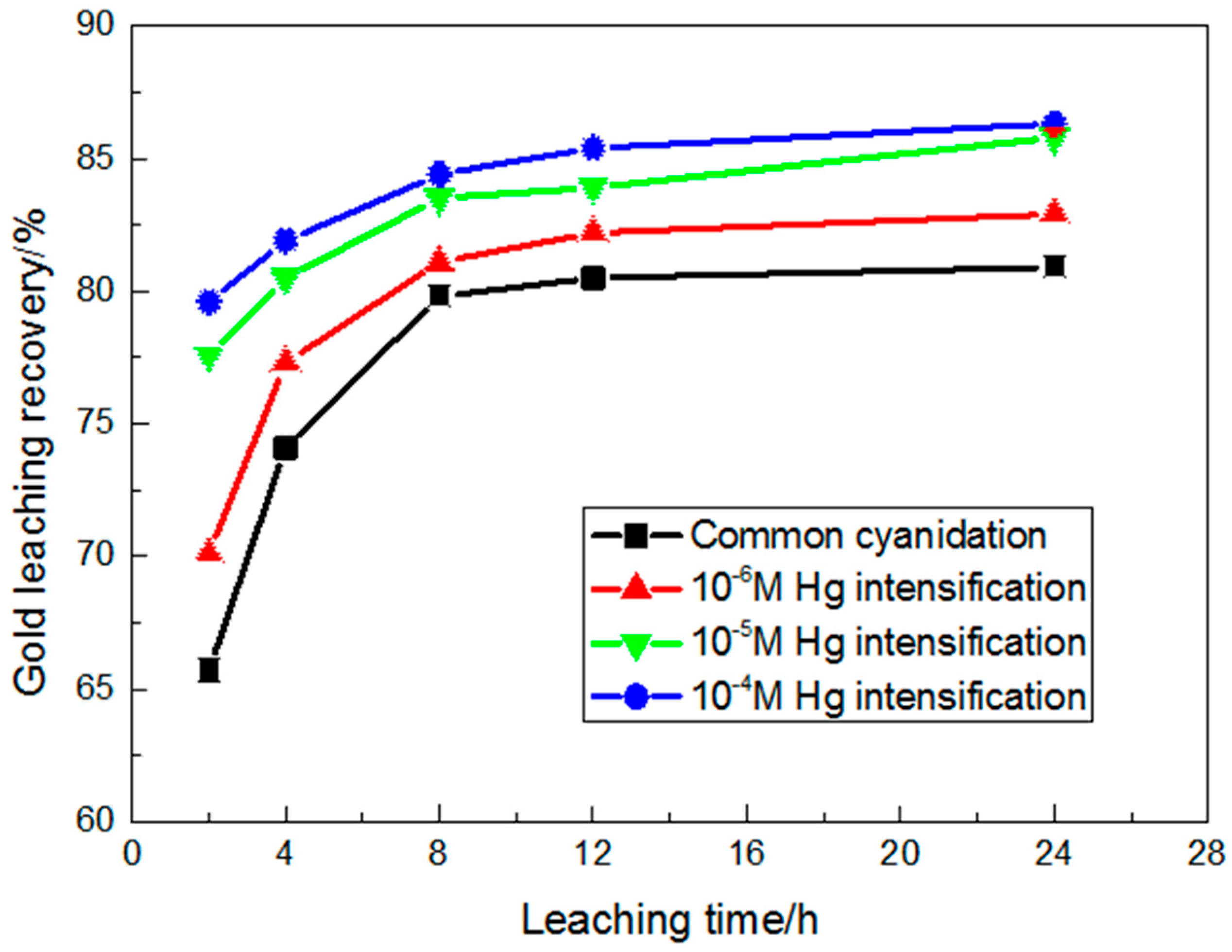
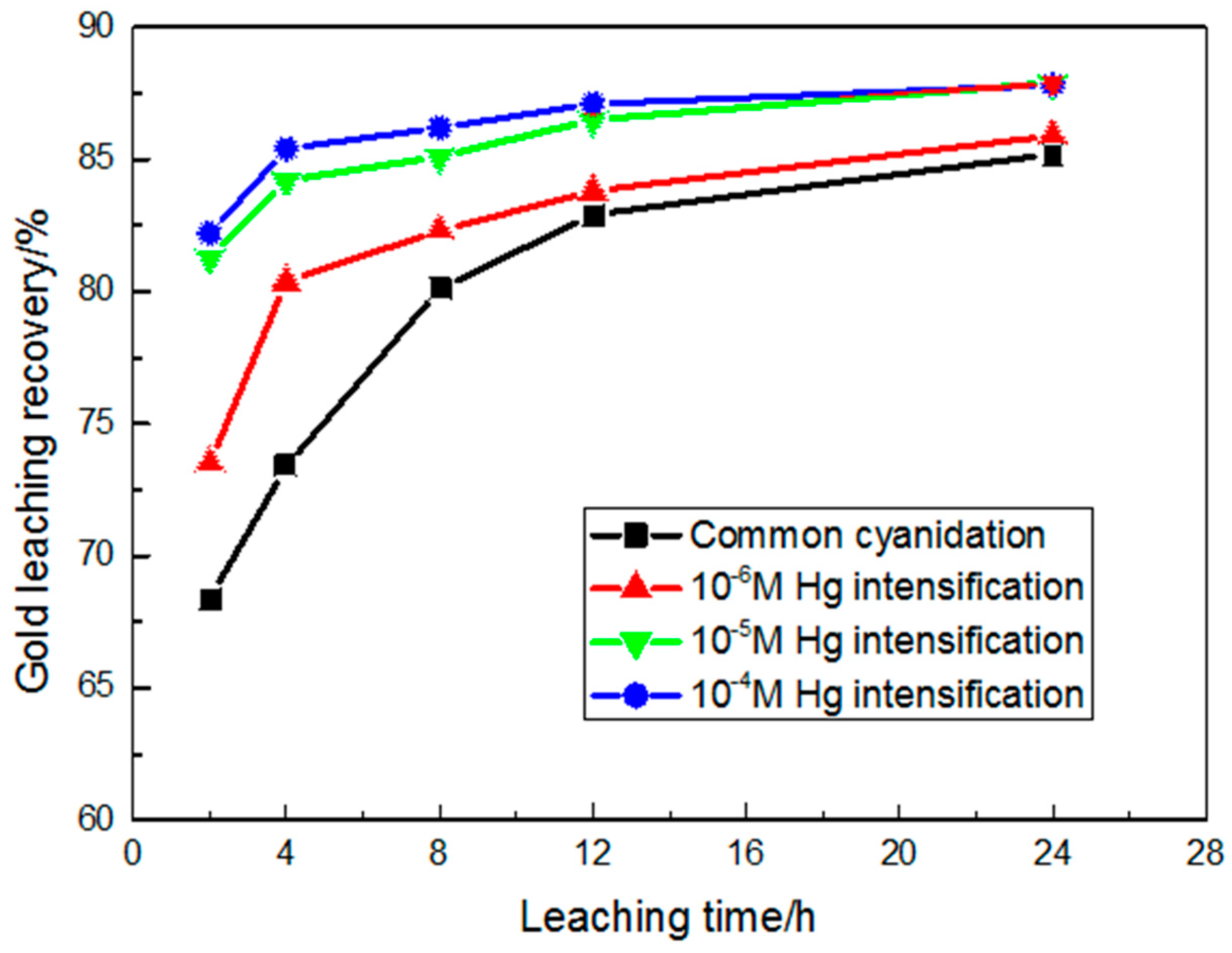
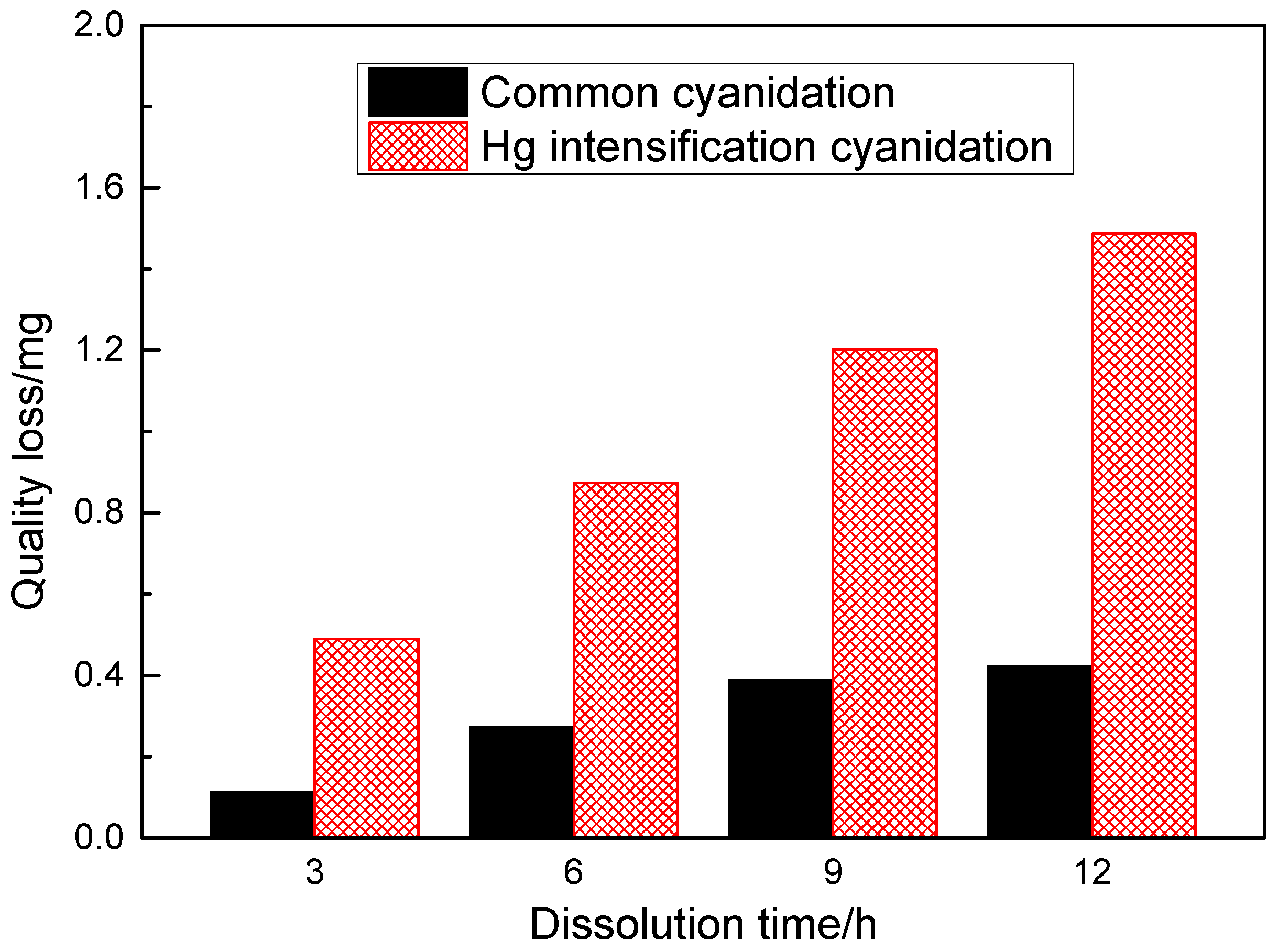
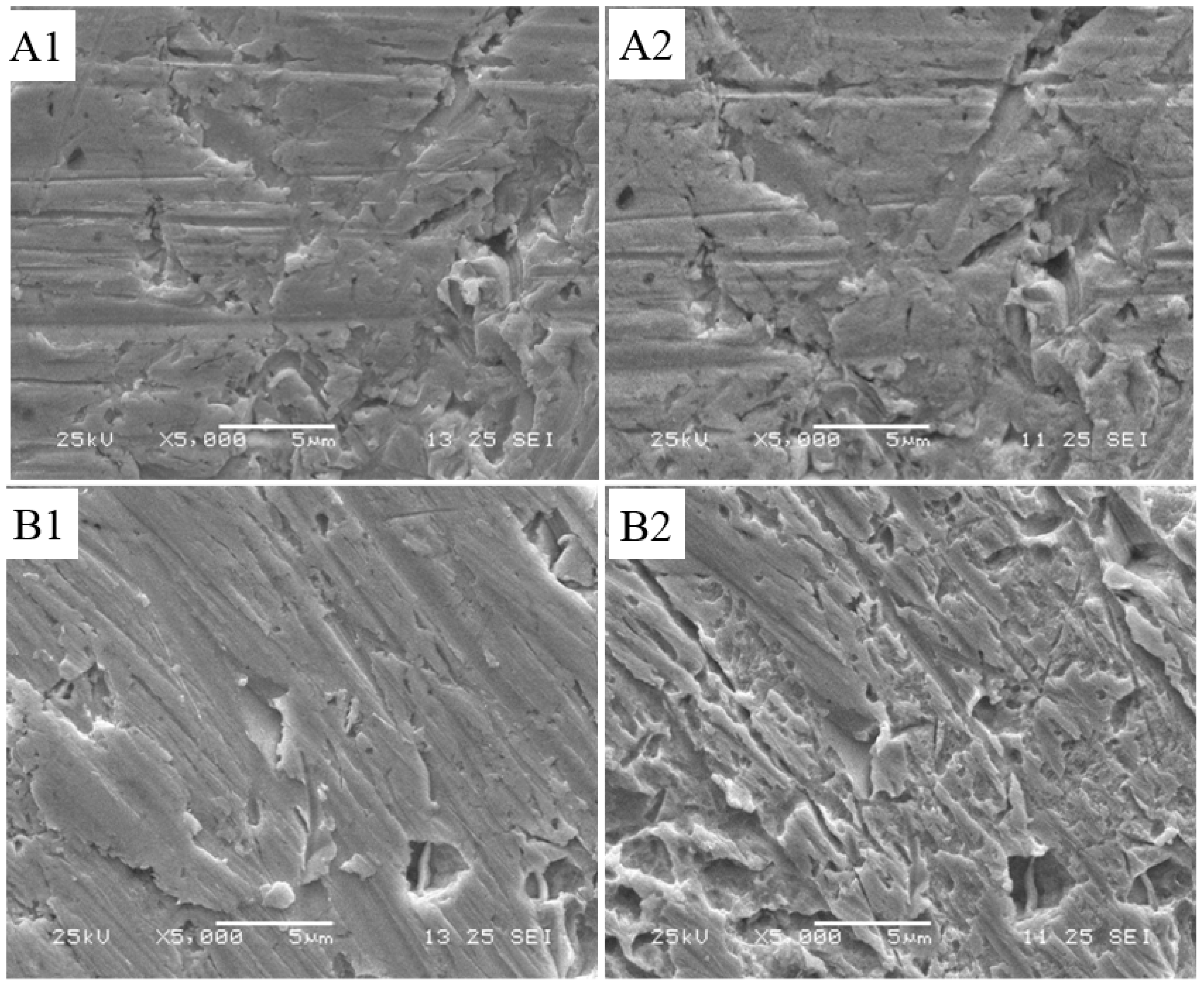
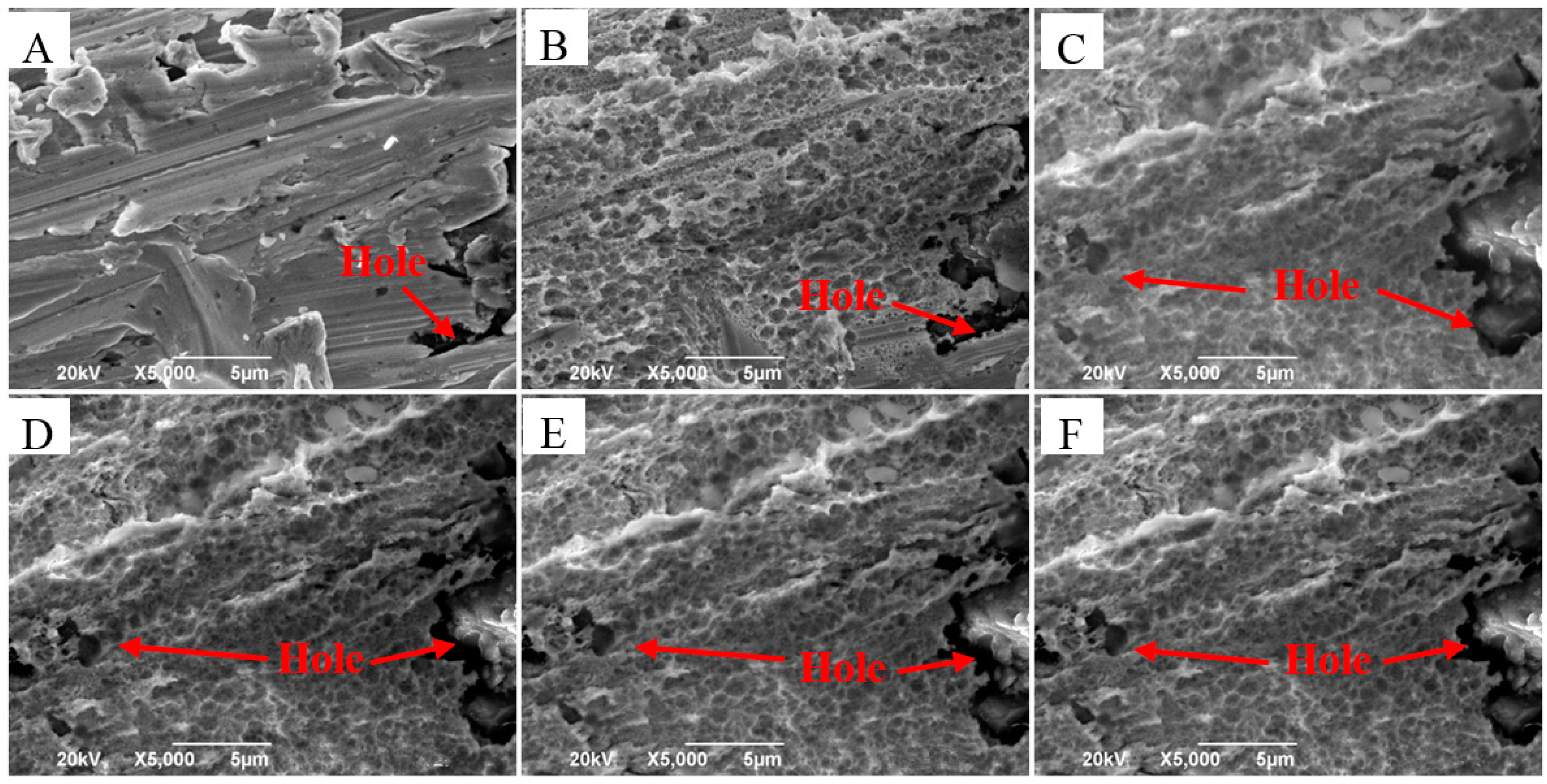

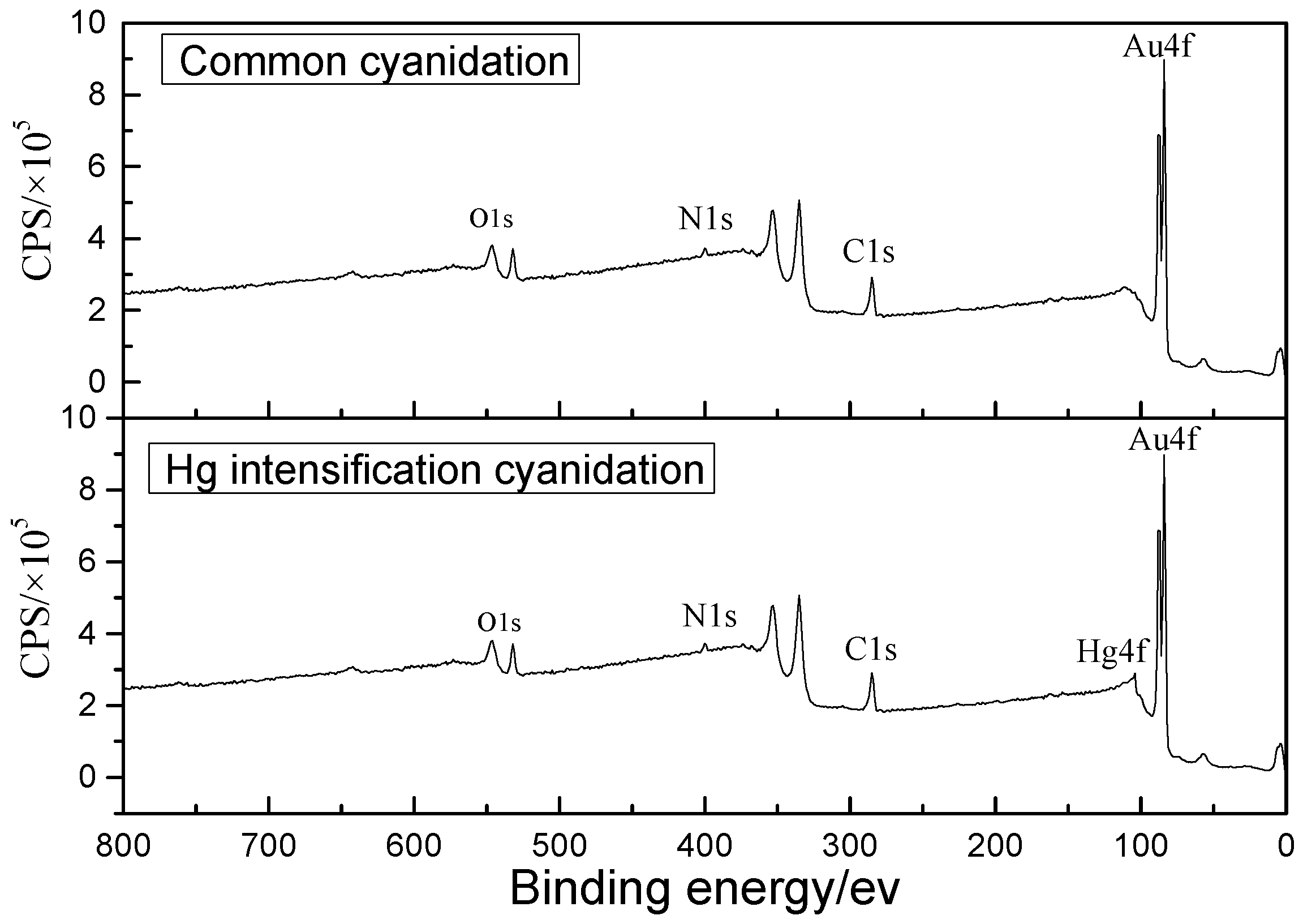


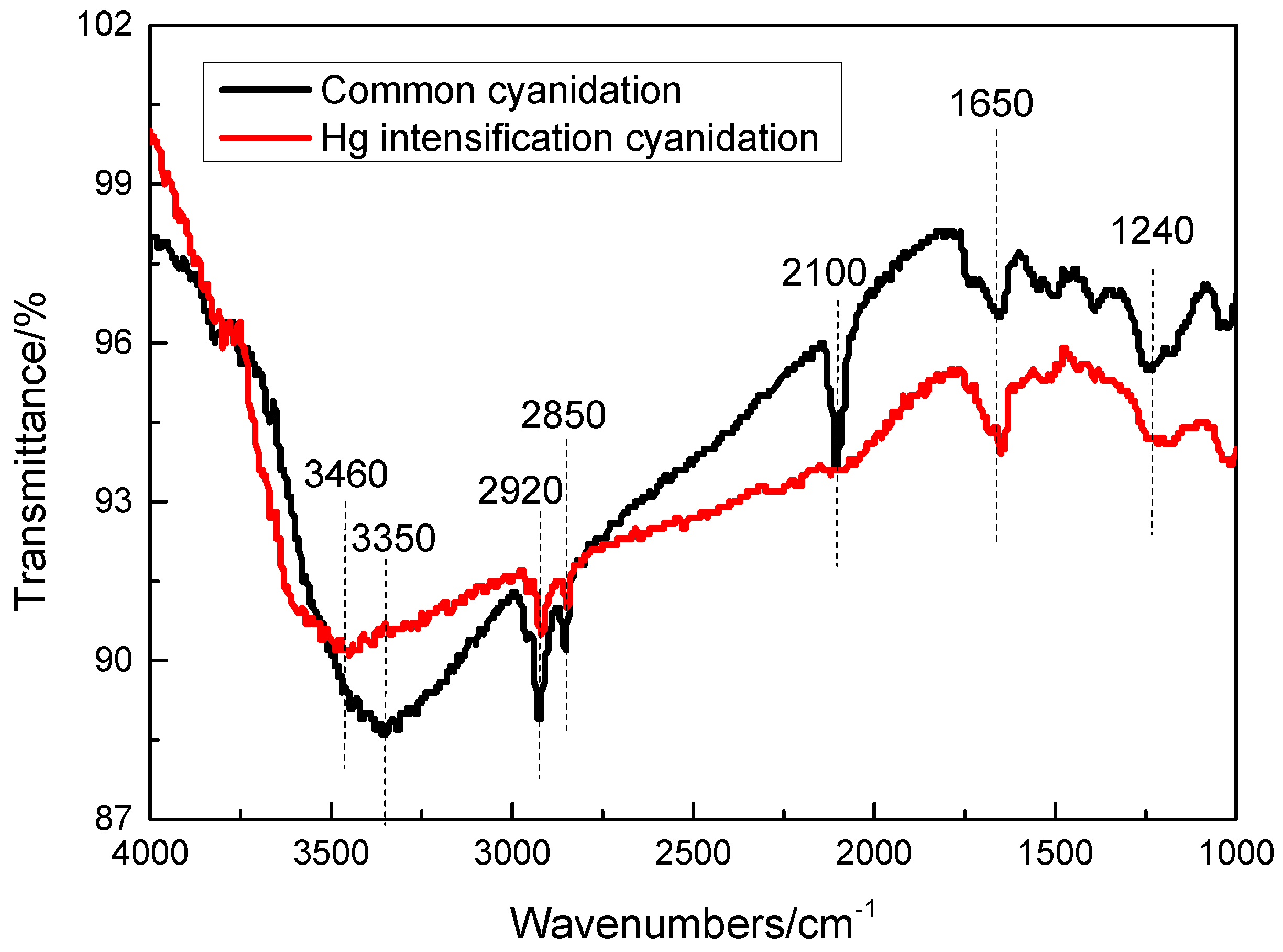
| Sample | Au * | Ag * | Cu | Pb | Zn | Fe | S |
|---|---|---|---|---|---|---|---|
| Sulphide gold concentrate | 73.21 | 176.05 | 2.19 | 0.98 | 1.03 | 29.57 | 28.34 |
| Oxide gold ore | 4.42 | 0.36 | 0.05 | 0.04 | 0.05 | 3.21 | 0.16 |
| Position (cm−1) | Assignment | Group |
|---|---|---|
| 1240 | O–H | Alcohol compound |
| 1650 | NO2 | Nitro compound |
| 2100 | C≡N | Cyanide compound |
| 2850, 2920 | C–H | Hydrocarbon compound |
| 3460, 3550 | O–H | Alkaline compound |
© 2018 by the authors. Licensee MDPI, Basel, Switzerland. This article is an open access article distributed under the terms and conditions of the Creative Commons Attribution (CC BY) license (http://creativecommons.org/licenses/by/4.0/).
Share and Cite
Zhong, Q.; Yang, Y.; Chen, L.; Li, Q.; Xu, B.; Jiang, T. Intensification Behavior of Mercury Ions on Gold Cyanide Leaching. Metals 2018, 8, 80. https://doi.org/10.3390/met8010080
Zhong Q, Yang Y, Chen L, Li Q, Xu B, Jiang T. Intensification Behavior of Mercury Ions on Gold Cyanide Leaching. Metals. 2018; 8(1):80. https://doi.org/10.3390/met8010080
Chicago/Turabian StyleZhong, Qiang, Yongbin Yang, Lijuan Chen, Qian Li, Bin Xu, and Tao Jiang. 2018. "Intensification Behavior of Mercury Ions on Gold Cyanide Leaching" Metals 8, no. 1: 80. https://doi.org/10.3390/met8010080





